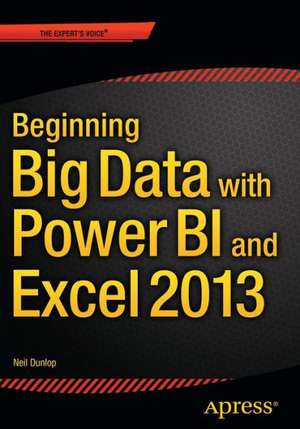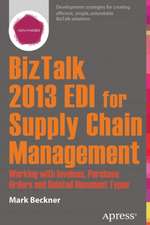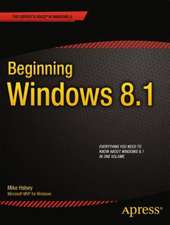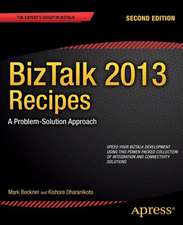Beginning Big Data with Power BI and Excel 2013: Big Data Processing and Analysis Using PowerBI in Excel 2013
Autor Neil Dunlopen Limba Engleză Paperback – 29 sep 2015
While Beginning Big Data with Power BI and Excel 2013 covers prominent tools such as Hadoop and the NoSQL databases, it recognizes that most small and medium-sized businesses don’t have the Big Data processing needs of a Netflix, Target, or Facebook. Instead, it shows how to import data and use the self-service analytics available in Excel with Power BI. As you’ll see through the book’s numerous case examples, these tools—which you already know how to use—can perform many of the same functions as the higher-end Apache tools many people believe are required to carry out in Big Data projects.
Through instruction, insight, advice, andcase studies, Beginning Big Data with Power BI and Excel 2013 will show you how to:
- Import and mash up data from web pages, SQL and NoSQL databases, the Azure Marketplace and other sources.
- Tap into the analytical power of PivotTables and PivotCharts and develop relational data models to track trends and make predictions based on a wide range of data.
- Understand basic statistics and use Excel with PowerBI to do sophisticated statistical analysis—including identifying trends and correlations.
- Use SQL within Excel to do sophisticated queries across multiple tables, including NoSQL databases.
- Create complex formulas to solve real-world business problems using Data Analysis Expressions (DAX).
Preț: 191.44 lei
Preț vechi: 239.30 lei
-20% Nou
Puncte Express: 287
Preț estimativ în valută:
36.63€ • 38.35$ • 30.31£
36.63€ • 38.35$ • 30.31£
Carte disponibilă
Livrare economică 15-29 martie
Preluare comenzi: 021 569.72.76
Specificații
ISBN-13: 9781484205303
ISBN-10: 1484205308
Pagini: 300
Ilustrații: XIX, 246 p. 284 illus.
Dimensiuni: 178 x 254 x 2 mm
Greutate: 0.47 kg
Ediția:1st ed.
Editura: Apress
Colecția Apress
Locul publicării:Berkeley, CA, United States
ISBN-10: 1484205308
Pagini: 300
Ilustrații: XIX, 246 p. 284 illus.
Dimensiuni: 178 x 254 x 2 mm
Greutate: 0.47 kg
Ediția:1st ed.
Editura: Apress
Colecția Apress
Locul publicării:Berkeley, CA, United States
Public țintă
Popular/generalNotă biografică
Neil Dunlop is Professor of Business and Computer Information Systems, Berkeley City College, Berkeley, CA. The author has served as chair of the Business and Computer Information Systems Departments for many years. He has over thirty-five years experience as a computer programmer and software designer and is the author of three books on database management. He is listed in Marquis Who’s Who in America and Who’s Who in the World.
Textul de pe ultima copertă
In Beginning Big Data with Power BI and Excel 2013, you will learn to solve business problems by tapping the power of Microsoft’s Excel and Power BI to import data from NoSQL and SQL databases and other sources, create relational data models, and analyze business problems through sophisticated dashboards and data-driven maps.
While Beginning Big Data with Power BI and Excel 2013 covers prominent tools such as Hadoop and the NoSQL databases, it recognizes that most small and medium-sized businesses don’t have the Big Data processing needs of a Netflix, Target, or Facebook. Instead, it shows how to import data and use the self-service analytics available in Excel with Power BI. As you’ll see through the book’s numerous case examples, these tools—which you already know how to use—can perform many of the same functions as the higher-end Apache tools many people believe are required to carry out in Big Data projects.
Through instruction, insight, advice, and casestudies, Beginning Big Data with Power BI and Excel 2013 will show you how to:
While Beginning Big Data with Power BI and Excel 2013 covers prominent tools such as Hadoop and the NoSQL databases, it recognizes that most small and medium-sized businesses don’t have the Big Data processing needs of a Netflix, Target, or Facebook. Instead, it shows how to import data and use the self-service analytics available in Excel with Power BI. As you’ll see through the book’s numerous case examples, these tools—which you already know how to use—can perform many of the same functions as the higher-end Apache tools many people believe are required to carry out in Big Data projects.
Through instruction, insight, advice, and casestudies, Beginning Big Data with Power BI and Excel 2013 will show you how to:
- Import and mash up data from web pages, SQL and NoSQL databases, the Azure Marketplace and other sources.
- Tap into the analytical power of PivotTables and PivotCharts and develop relational data models to track trends and make predictions based on a wide range of data.
- Understand basic statistics and use Excel with PowerBI to do sophisticated statistical analysis—including identifying trends and correlations.
- Use SQL within Excel to do sophisticated queries across multiple tables, including NoSQL databases.
- Create complex formulas to solve real-world business problems using Data Analysis Expressions (DAX).
Caracteristici
In Beginning Big Data with Power BI and Excel 2013, you will learn to solve business problems by tapping the power of Microsoft’s Excel and Power BI to import data from NoSQL and SQL databases and other sources, create relational data models, and analyze business problems through sophisticated dashboards and data-driven maps.




























